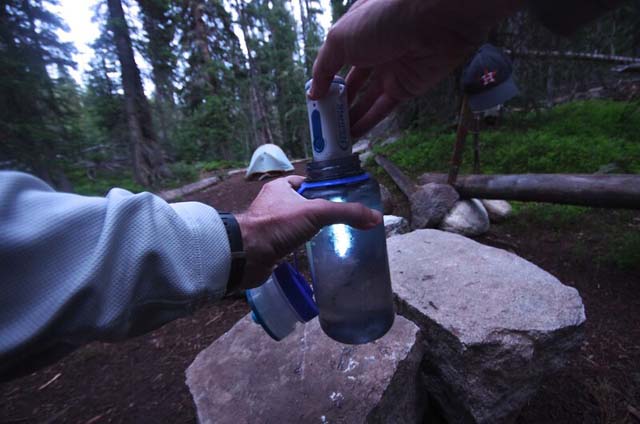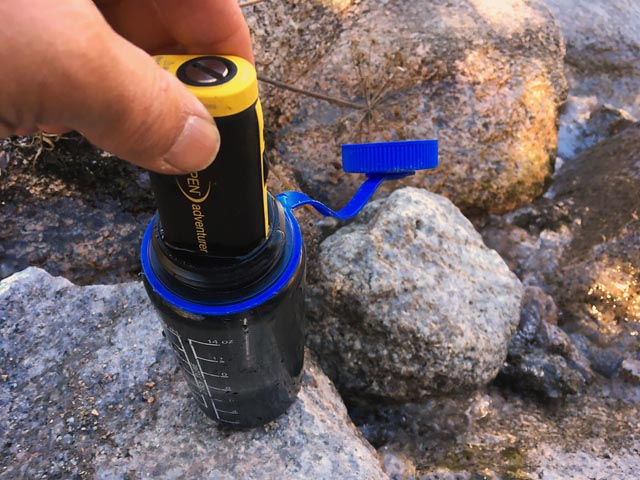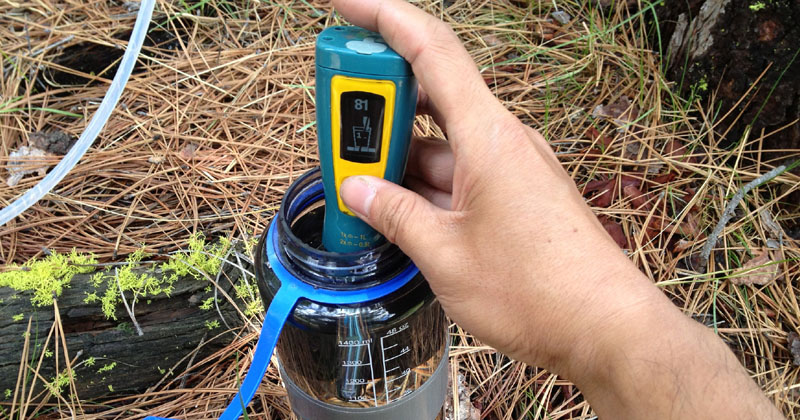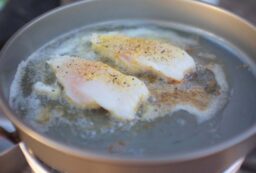Whether backpacking in the wilderness or in developing countries, a good water purifier is one of the best gear to bring. Having a water purifier means that you don’t ever have to buy bottled water (and contribute to plastic waste). Nor do you have to worry about lugging heavy bottles of water up mountains when you can just drink directly from streams. There are a lot of different purifiers, but SteriPEN is one of the best options.
In this SteriPEN review, I’ll go over everything you need to know about SteriPEN including how it works, how to use SteriPEN, the different types of SteriPEN, and some good alternatives to SteriPEN.
What Is SteriPEN?

SteriPEN is a type of water purifier that uses ultraviolet (UV) light to deactivate harmful pathogens in water. The keyword here is deactivate. Unlike water filters, the SteriPEN doesn’t actually remove the pathogens. You can buy the SteriPEN here.
Instead the UV light damages the DNA of the pathogens and makes it impossible for them to reproduce. If the pathogen cannot reproduce, it cannot cause infection.
Fun fact: UV light can even kill bacteria and viruses in the air. One theory as to why we get sick more in winter is because there isn’t as much UV light from the sun to kill airborne pathogens. (1, 2, 3, 4)
| Pros | Cons |
|---|---|
| No squeezing | Requires batteries |
| Very fast and easy | Don't treat large organisms like worm eggs |
| Treats viruses as well as bacteria and protozoa | Won't remove sediment, chemicals, bad tastes, or smells |
| Fairly lightweight | UV bulb fairly fragile |
| Good for travel abroad and hiking | Not effective on cloudy water |
What Does SteriPEN Treat?
SteriPEN uses a UV intensity of 254nm, which is very effective at treating pathogens in water. When used correctly, it will treat 99.9% of the following pathogens:
- Bacteria: Including Campylobacter, E. Coli, Salmonella, and Shigella
- Protozoa: Including Giardia and Cryptosporidium
- Viruses: Including rotovirus and hepatitis
SteriPEN Does NOT Treat:
- Chemicals or toxins: Such as fertilizers, pesticides, or chemical runoff.
- Larger organisms: Such as tapeworm eggs.
- Cloudy water: The UV light won’t be able to get to the pathogens if the water is murky.
What does this mean for real-life use?
Travel in Undeveloped Countries:
You can use SteriPEN on tap water in underdeveloped countries. However, it’s not going to be completely effective if the water might be contaminated by chemicals, such as near agricultural or mining areas.
You don’t ever want to drink chemicals, but a few days’ worth of exposure probably isn’t going to give you cancer. On the plus side, chemicals don’t cause traveler’s diarrhea like bacteria, protozoa, and viruses do, so using SteriPEN will spare you that terrible ordeal!
Backcountry Water:
With backcountry water, things get a bit more complex. It used to be that you could just use a water filter in the backcountry. However, viruses are becoming more common in backcountry water because of overcrowding and people going to the bathroom near water sources (follow Leave No Trace, people!!!).
SteriPEN will purify bacteria, parasites, and viruses, but it won’t remove those parasites like tapeworm eggs. So, you wouldn’t want to rely on SteriPEN alone when drinking from streams, lakes, rivers, or private wells. You’ll have to get a filter which can remove viruses too (which has it’s drawbacks) or use SteriPEN in addition to a water filter.
How to Use SteriPEN

Using SteriPEN is really simple. However, it’s really important that you use it correctly. Otherwise the UV light won’t be able to reach all the pathogens in the water.
- Only use on clear water: Some of the SteriPEN products can be used with cloudy water, but not anything very dark. You need the water to be like a light lemonade. If the water is murky, then you’ll need to pre-filter it.
- Determine how much water you are purifying: Either ½ or 1 liter of water.
- Remove lamp cover and click: Use 1 click for ½ liter and 2 clicks for 1 liter of water.
- Put the lamp into the water: Depending on the model you have, a green light might flash after you click. Put the lamp wand into the water while it is flashing. Once the lamp detects water, it will emit UV light.
- Stir until the lamp turns off: It’s important that you stir. This agitates the water and ensures all pathogens make it into the UV light. When the lamp turns off, you are done. It takes 48 seconds to purify ½ liter of water and 90 seconds for one liter.
Notes:
- It’s really important that you agitate the water while using the SteriPEN. One independent study found that SteriPEN only treated 94.98% of spores when the water wasn’t agitated.
- The pre-filter sold by SteriPEN is only 40 microns. That’s enough to remove sediment and make the water look clear so it can be treated by the SteriPEN UV light. However, it is not small enough to remove tapeworm eggs and other parasite eggs. You can see a list of parasite egg sizes here. Play it safe: I’d recommend using a pre-filter with an absolute rating of at most 1 micron.
Isn’t UV Light Bad for Humans?
Yes, UV light can be very dangerous for humans. However, SteriPEN is usually used in water bottles. The plastic, glass, or metal will block the UV light. If you are using the SteriPEN in a large pot though, some of the UV light could get to your eyes and cause damage.
One cool thing is that SteriPEN only turns on if it detects water. This feature makes it impossible for you to accidentally blast yourself with UV light.
SteriPEN Comparison
There are several versions of SteriPEN out. In my opinion, the SteriPEN Ultra (get it here) is the best version because it can be recharged via USB. I typically bring a lightweight power bank on my backpacking trips, which is enough to recharge my devices, headlamps, and a SteriPEN. On longer trips, you can bring a portable solar panel.
| Batteries | Liters of Water Treated Per Battery/Charge | Weight | Use on Cloudy Water? | |
|---|---|---|---|---|
| SteriPEN Classic | 4 AA batteries | 100 (with 2,300 NiMH batteries) | 6.3oz | No |
| SteriPEN Ultra | Internal USB-rechargeable lithium-ion | 50 | 5oz | No |
| SteriPEN Ultralight | 2 CR123 | 20 | 4.8oz | No |
| SteriPEN Adventurer Opti | 2 CR123 | 50 | 3.6oz | Yes |
The Bottom Line?
The SteriPEN is a great way to treat unsafe tap water when traveling abroad. However, it has a lot of drawbacks for wilderness backpacking – particularly that it doesn’t work on murky water, won’t remove sediment or worm eggs, and relies on batteries.
If you want to use SteriPEN in the backcountry, I’d recommend using it along with a cheap filter like the Sawyer Mini. The filter takes care of sediment and large parasites. The SteriPEN then destroys viruses.
If you’d rather only use one purifier, then get yourself the MSR Guardian filter. It’s expensive but lasts almost forever and handles everything except chemicals.
Image credits:
“Sanitizing water with my Steripen. I als” (CC BY 2.0) by ryochiji
“Steripen” (CC BY-NC 2.0) by AlphaTangoBravo / Adam Baker
“IMG_6762” (CC BY 2.0) by Tim Berger













1 Comment
“Bumsly Owl”
June 26, 2023 at 8:27 amThankyou 4 the research time and miles on the trail. I’m a devoted steripen user but for 1st time i am going where tapeworm eggs are a reality, so i must find a filter that doesnt take forever or weigh much